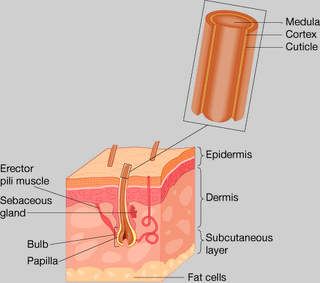Hair: An Overview

What Exactly Is Hair?
Hair consists of the shaft, protruding above the skin, and the root, which is sunk in a follicle, or pit, beneath the skin surface. Except for a few growing cells at the base of the root, the hair is dead tissue and is composed of keratin and related proteins. The hair follicle is a tubelike pocket of the epidermis, that encloses a small section of the dermis at its base. Human hair is formed by rapid divisions of cells at the base of the follicle. As the cells are pushed upward from the follicle's base, they harden and undergo pigmentation. The bundles of keratin in hair is connected through disulphide bonds. These bonds are strong and are responsible for the shaft's shape. The more linkages there are, the flatter the shaft which results in a curl of the shaft. The lesser bonds there are, the more circular the shape of the shaft which is seen in straight hair. Hydroden bonds (H-bond) in the hair are formed from the moisture in the air. These bonds have the ability to give the hair a temporary set when hair is managed with a dryer. These bonds are responsible for the hair's elasticity and they are broken when hair is in contact with water.
The hair on our scalps and in our eyebrows and eyelashes are different from other bodily hairs. The hair on our heads grows a healthy 0.5 inch per month, and long scalp hairs have an average life of 3 to 5 years. Most of us have between 100,000 and 150,000 hairs on our heads! Lol!
There are two kinds of melanin found in the hair: eumelanin (the most common and responsible for hair shades from brown to black) and phaeomelanin (responsible for yellowish-blond, ginger and red colors). Absence of pigment produces white/gray hair.

0 Comments:
Post a Comment
Subscribe to Post Comments [Atom]
<< Home